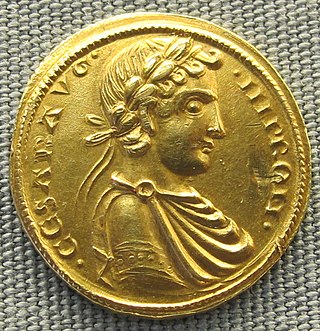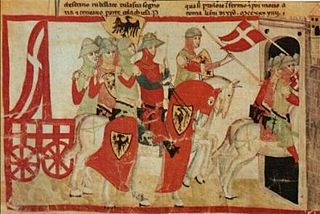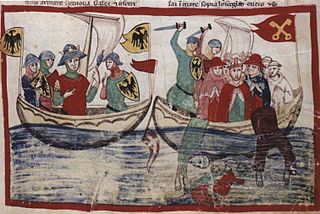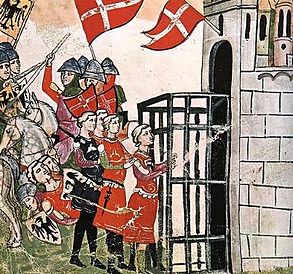
Frederick II was King of Sicily from 1198, King of Germany from 1212, King of Italy and Holy Roman Emperor from 1220 and King of Jerusalem from 1225. He was the son of emperor Henry VI of the Hohenstaufen dynasty and Queen Constance of Sicily of the Hauteville dynasty.

Cremona is a city and comune in northern Italy, situated in Lombardy, on the left bank of the Po river in the middle of the Pianura Padana. It is the capital of the province of Cremona and the seat of the local city and province governments. The city of Cremona is especially noted for its musical history and traditions, including some of the earliest and most renowned luthiers, such as Giuseppe Guarneri, Antonio Stradivari, Francesco Rugeri, Vincenzo Rugeri, and several members of the Amati family.

The Guelphs and Ghibellines were factions supporting the Pope and the Holy Roman Emperor, respectively, in the Italian city-states of Central Italy and Northern Italy.

The Lombard League was a medieval alliance formed in 1167, supported by the popes, to counter the attempts by the Hohenstaufen Holy Roman emperors to assert influence over the Kingdom of Italy as a part of the Holy Roman Empire. At its apex, it included most of the cities of Northern Italy, but its membership changed with time. With the death of the third and last Hohenstaufen emperor, Frederick II, in 1250, it became obsolete and was disbanded.

The Battle of Cortenuova was fought on 27 November 1237 in the course of the Guelphs and Ghibellines Wars: in it, Holy Roman Emperor Frederick II defeated the Second Lombard League.

Ezzelino III da Romano was an Italian feudal lord, a member of the Ezzelino family, in the March of Treviso. He was a close ally of the emperor Frederick II, and ruled Verona, Vicenza and Padua for almost two decades. He became infamous as a cruel tyrant, and was, in fact, the most "notorious" of the "early tyrants".

The Bentivoglio family was an Italian noble family that became the de facto rulers of Bologna and responsible for giving the city its political autonomy during the Renaissance, although their rule did not survive a century.

The Battle of Montaperti was fought on 4 September 1260 between Florence and Siena in Tuscany as part of the conflict between the Guelphs and Ghibellines. The Florentines were routed. It was the bloodiest battle fought in Medieval Italy, with more than 10,000 fatalities. An act of treachery during the battle is recorded by Dante Alighieri in the Inferno section of the Divine Comedy.

Enzo was an illegitimate son of the Hohenstaufen emperor Frederick II, who appointed him 'King of Sardinia' in 1238. He played a major role in the wars between Guelphs and Ghibellines in the Imperial kingdom of Italy, and was captured by his enemies in 1249. He remained imprisoned in Bologna until his death.
The Battle of Zappolino, the only battle of the War of the Oaken Bucket, was fought in November 1325 between forces representing the Italian towns of Bologna and Modena, an incident in the series of raids and reprisals between the two cities that were part of the larger conflicts of Guelphs and Ghibellines. The Modenese were victorious. Though many clashes between Guelphs and Ghibellines loomed larger to contemporaries than to historians, the unusually-large encounter involved 4000 estimated cavalry and some 35,000 foot soldiers, and 2000 men lost their lives. The location of the battle, at the foot of a hill just outside the castle walls, is now a frazione of the municipality of Castello di Serravalle, Emilia-Romagna.
The siege of Faenza occurred from August 1240 to April 14, 1241, during the course of the wars of the Guelphs and the Ghibellines. In this military confrontation, the Holy Roman Emperor Frederick II aggressively laid siege to the town of Faenza and successfully captured the city.

The Battle of Parma was fought on 18 February 1248 between the forces of Holy Roman Emperor Frederick II and the Lombard League. The Guelphs attacked the Imperial camp when Frederick II was away. The Imperial forces were defeated and much of Frederick's treasure was lost.

The naval Battle of Giglio was a military clash between a fleet of the Holy Roman Emperor Frederick II and a fleet of the Republic of Genoa in the Tyrrhenian Sea. It took place on Friday, May 3, 1241 between the islands of Montecristo and Giglio in the Tuscan Archipelago and ended with the victory of the Imperial fleet.

Palazzo Re Enzo is a palace located on Piazza del Nettuno, 1 in the historic center of Bologna, northern Italy. The palace takes its name from Enzio of Sardinia, Frederick II's son, who was prisoner here from 1249 until his death in 1272. The palace is presently used to sponsor cultural events and exhibitions.

The flag of the Holy Roman Empire was not a national flag, but rather an imperial banner used by the Holy Roman Emperor; black and gold were used as the colours of the imperial banner, a black eagle on a golden background. After the late 13th or early 14th century, the claws and beak of the eagle were coloured red. From the early 15th century, a double-headed eagle was used.
The War of the Bucket or the War of the Oaken Bucket was fought in 1325 between the rival city-states of Bologna and Modena. It took place in the region of Emilia-Romagna, in northern Italy. The war was an episode in the over 300-year-long struggle between Guelphs and Ghibellines. Modena won the Battle of Zappolino, the only battle of the war.

The Battle of Cassano was fought in the Autumn of 1259 between Guelph and Ghibelline armies in Northern Italy.
Ottaviano or Attaviano degli Ubaldini was an Italian cardinal, often known in his own time as simply Il Cardinale.
The Battle of Calcinato was a military engagement during the wars between the Guelphs and Ghibellines. It took place on 9 August 1201 near Calcinato, southeast of Brescia. The Ghibelline forces won.
The battle of San Cesario in August 1229 was the culmination of a civil war between the members of the Lombard League. In the pitched battle, Modena and its allies defeated Bologna and its allies.














